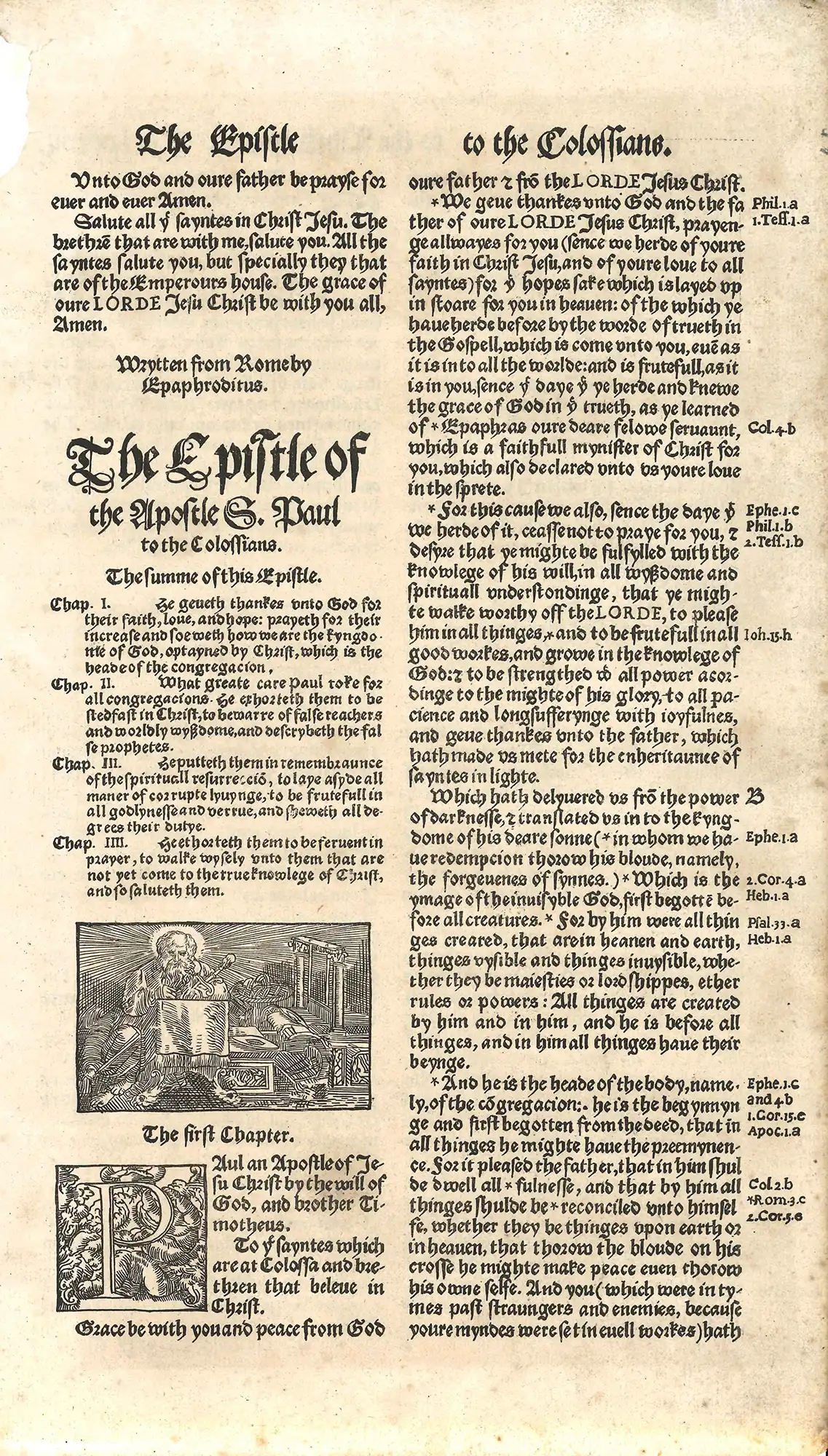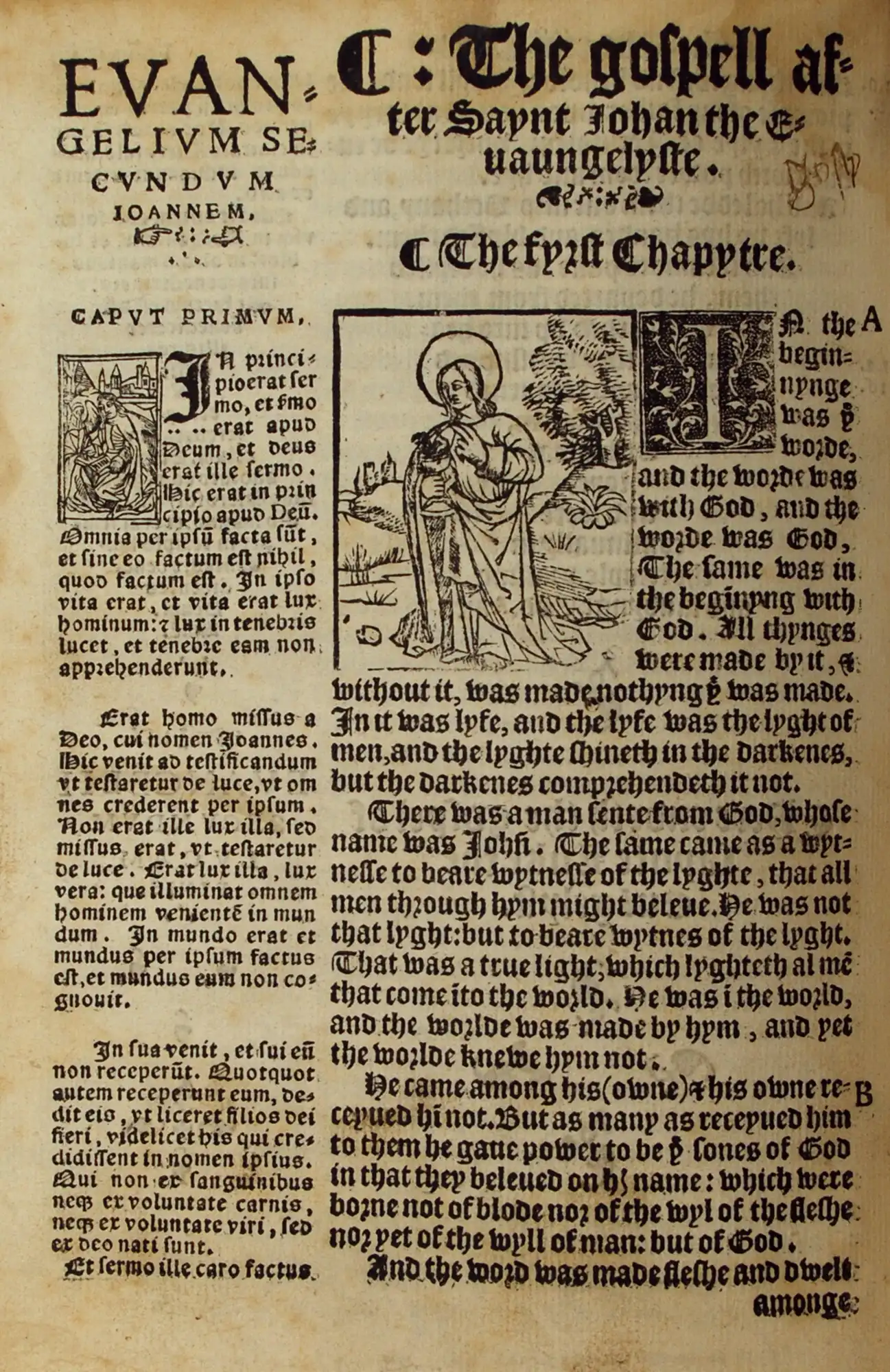Case 13
- Early Printed English Bibles

Biblia: the Byble, that is, the holy Scrypture of the Olde and New Testament, faithfully and truly translated out of Douche and Latyn in to Englishe. Antwerp: Printed by Merten de Keyser, 1535. Single leaf.
Myles Coverdale (ca.1488-1569) issued the first complete English Bible in 1535. It was printed and prepared on the Continent in Antwerp and dedicated to Henry VIII whom Coverdale invited to correct, improve of reject his translation. Its printing coincided with the ecclesiastical reforms of Henry VIII who allowed Coverdale’s Bible to circulate freely in England, though it was not authorised for use in churches. However, when Henry desired an authorised version in English, it was Coverdale to whom he turned.
The Reed Collection includes a single leaf from the 1535 first edition of Coverdale’s Bible (displayed here) and the 1550 edition. This leaf contains part of Paul’s Letter to the Philippians 3:3 and his Letter to the Colossians 1:21. Coverdale drew heavily from William Tyndale for his New Testament and Pentateuch translations.

Biblia: the Byble, that is, the holy Scrypture of the Olde and New Testament, faithfully and truly translated out of Douche and Latyn in to Englishe. Antwerp: Printed by Merten de Keyser, 1535. Single leaf.
Open image in new window
![The New Testament of oure Sauyour Iesu Christ, faithfully translated & lately correcte with a true concordaunce in the margent & many necessary annotacions declarynge sondry harde places co[n]teyned in the text. [Antwerp: Matthew Crom], 1538.](https://www.reedgallery.co.nz/__data/assets/image/0008/999692/13b.webp)
The New Testament of oure Sauyour Iesu Christ, faithfully translated & lately correcte with a true concordaunce in the margent & many necessary annotacions declarynge sondry harde places co[n]teyned in the text. [Antwerp: Matthew Crom], 1538.
Displayed here is one of the earliest separate issues of the New Testament translation by Miles Coverdale, with illustrations designed by Lieven de Witte (ca. 1503-78), a painter of Ghent.
Matthew Crom was a Netherlandish printer who issued around 80 publications in Antwerp between 1537 and 1546, often under anonymous imprints. In 1537, he printed the ‘Matthew’s Bible’ for the London publishers Richard Grafton and Edward Whitchurch. His Protestantism prompted his flight to England in 1546.
![The New Testament of oure Sauyour Iesu Christ, faithfully translated & lately correcte with a true concordaunce in the margent & many necessary annotacions declarynge sondry harde places co[n]teyned in the text. [Antwerp: Matthew Crom], 1538.](https://www.reedgallery.co.nz/__data/assets/image/0008/999692/13b.webp)
The New Testament of oure Sauyour Iesu Christ, faithfully translated & lately correcte with a true concordaunce in the margent & many necessary annotacions declarynge sondry harde places co[n]teyned in the text. [Antwerp: Matthew Crom], 1538.
Open image in new window

The Newe Testament: in Englyshe and Latyn accordyng to the translacyon of doctour Erasmus of Roterodam. Prynted in Fletestrete by Robert Redman, 1538.
By the time of the ascension of Henry VIII in 1509, England was the only major European country still without such a native-language version of the Bible. This changed with the publication of an English New Testament by William Tyndale (ca. 1494-1536) in 1526, but the work was considered heretical under the 1409 ruling of the Oxford synod.
This 1538 New Testament is the earliest diglot containing Tyndale’s English New Testament with the Latin of Desiderius Erasmus (1466-1536). In its colophon, the name of Erasmus is clearly noted, yet although the work was published just one year before the first authorised English Bible, no mention is made of William Tyndale. His name was still considered heretical.
The printer Robert Redman was active in London from 1525 to 1540 and seems to have specialised in law books – a field long dominated by Robert Pynson, the main printing rival to Wynkyn de Worde. Upon Pynson’s death in 1530, Redman took over his printing offices in Fleet Street, as well as his materials and devices.

The Newe Testament: in Englyshe and Latyn accordyng to the translacyon of doctour Erasmus of Roterodam. Prynted in Fletestrete by Robert Redman, 1538.
Open image in new window

![The New Testament of oure Sauyour Iesu Christ, faithfully translated & lately correcte with a true concordaunce in the margent & many necessary annotacions declarynge sondry harde places co[n]teyned in the text. [Antwerp: Matthew Crom], 1538.](https://www.reedgallery.co.nz/__data/assets/image/0008/999692/13b.webp)
